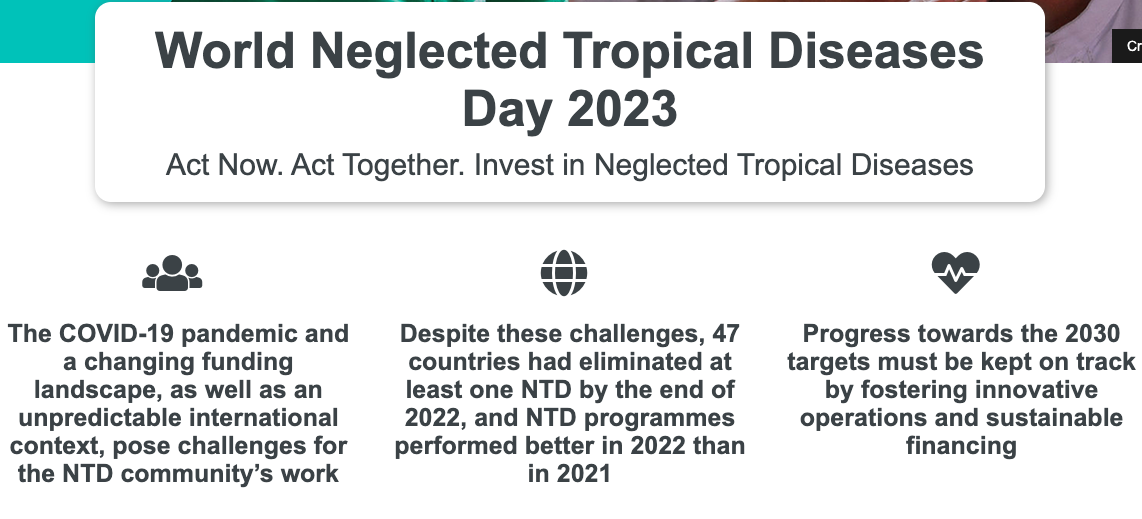
Neglected tropical diseases (NTDs) are widespread in the world’s poorest regions, where water safety, sanitation and access to health care are less than optimal. NTDs affect over 1 billion people globally and are caused by a variety of pathogens including viruses, bacteria, parasites, fungi, and toxins.
These diseases are “neglected” because they are almost absent from the global health agenda, receive little funding and are associated with stigma and social exclusion. They are diseases of neglected populations and perpetuate a cycle of poor educational outcomes and limited professional opportunities.
Brief summary
World NTD Day 2023
Buruli ulcer
A debilitating mycobacterial skin infection causing severe destruction of the skin, bone and soft tissue.
Chagas Disease
A life-threatening protozoan illness transmitted to humans through contact with vector insects (triatomine bugs), ingestion of contaminated food, infected blood transfusions, congenital transmission, organ transplantation or laboratory accidents.
Dengue and chikungunya
Two mosquito-borne, outbreak-prone viral conditions causing a flu-like illness that can be associated with severe, painful and disabling symptoms and, in the case of dengue, may cause shock, haemorrhage and death.
Dracunculiasis (guinea-worm disease)
A helminth infection transmitted exclusively by drinking water contaminated with parasite-infected water fleas; one year later, adult female worms painfully ulcerate through the skin, often of the legs, in order to expel their larvae.
Echinococcosis
A disease caused by the larval stages of tapeworms forming pathogenic cysts in human organs, acquired by ingesting eggs most commonly shed in the faeces of dogs and wild animals.
Foodborne trematodiases
A group of infectious diseases acquired by consuming fish, crustaceans and vegetables contaminated with larval parasites; clonorchiasis, opisthorchiasis, paragonimiasis and fascioliasis are the most common.
Human African trypanosomiasis (sleeping sickness)
A protozoan infection spread by the bites of tsetse flies that is almost 100% fatal without prompt diagnosis and treatment to prevent the parasites from invading the central nervous system.
Leishmaniases
A group of protozoan diseases transmitted through the bites of infected female sandflies; the most severe (visceral) form attacks the internal organs and in its most prevalent (cutaneous) form causes skin ulcers, disfiguring scars and disability.
Leprosy
A complex disease caused by infection with a slow-growing bacterium, mainly affecting the skin, peripheral nerves and eyes.
Lymphatic filariasis (elephantiasis)
A helminth infection transmitted by mosquitoes and resulting in adult worms inhabiting and reproducing in the lymphatic system; it is associated with recurrent painful inflammation and abnormal enlargement of limbs and genitals.
Mycetoma, chromoblastomycosis and other deep mycoses
Chronic, progressively destructive inflammatory diseases of the skin and subcutaneous tissues which usually affect the lower limbs. People become infected when injuries break the skin and allow fungi (and bacteria in the case of mycetoma) to enter the body.
Onchocerciasis (river blindness)
A helminth infection transmitted by the bite of infected blackflies causing severe itching and eye lesions as the adult worm produces larvae eventually leading to visual impairment and permanent blindness.
Rabies
A preventable viral disease transmitted to humans through the bites of infected animals, especially dogs, that is invariably fatal once symptoms develop.
Scabies and other ectoparasitoses
A group of infestations of the skin caused by mites, fleas or lice; scabies occurs when the human itch mite burrows into the upper layer of the skin where it lives and lays its eggs, causing intense itching and rash.
Schistosomiasis (bilharzia)
A group of trematode infections acquired when larval forms released by freshwater snails penetrate human skin during contact with infested water; schistosomiasis is typically associated with liver and urogenital pathology.
Snakebite envenoming
A potentially life-threatening condition caused by toxins injected through the bite of a venomous snake, often responsible for acute medical emergencies. Envenoming can also be caused by having venom sprayed into the eyes by certain species of snakes
Soil-transmitted helminthiases
Helminth infections transmitted through soil contaminated by human faeces; they cause anaemia, vitamin A deficiency, stunted growth, malnutrition, intestinal obstruction and impaired development.
Taeniasis and cysticercosis
Taeniasis is caused by adult tapeworms in human intestines; cysticercosis results when humans ingest tapeworm eggs that develop as larvae in tissues, including the brain (neurocysticercosis).
Trachoma
A bacterial infection transmitted through direct contact with infectious eye or nasal discharge, and associated with unsafe living conditions and hygiene practices; if left untreated, it causes irreversible corneal opacities and blindness.
Yaws
A chronic, disfiguring bacterial disease affecting mainly the skin and bone. Other endemic treponematoses similar to yaws are also considered NTDs












